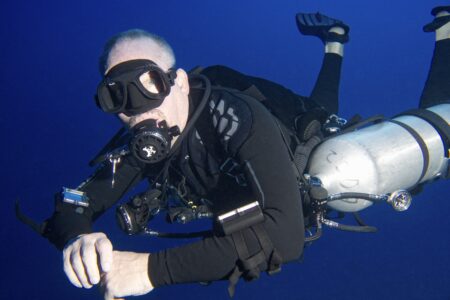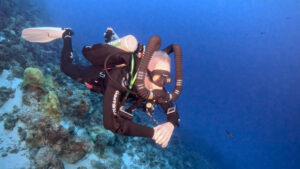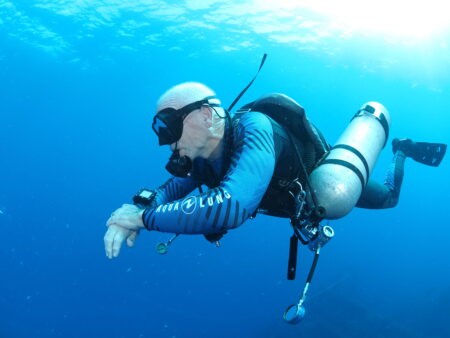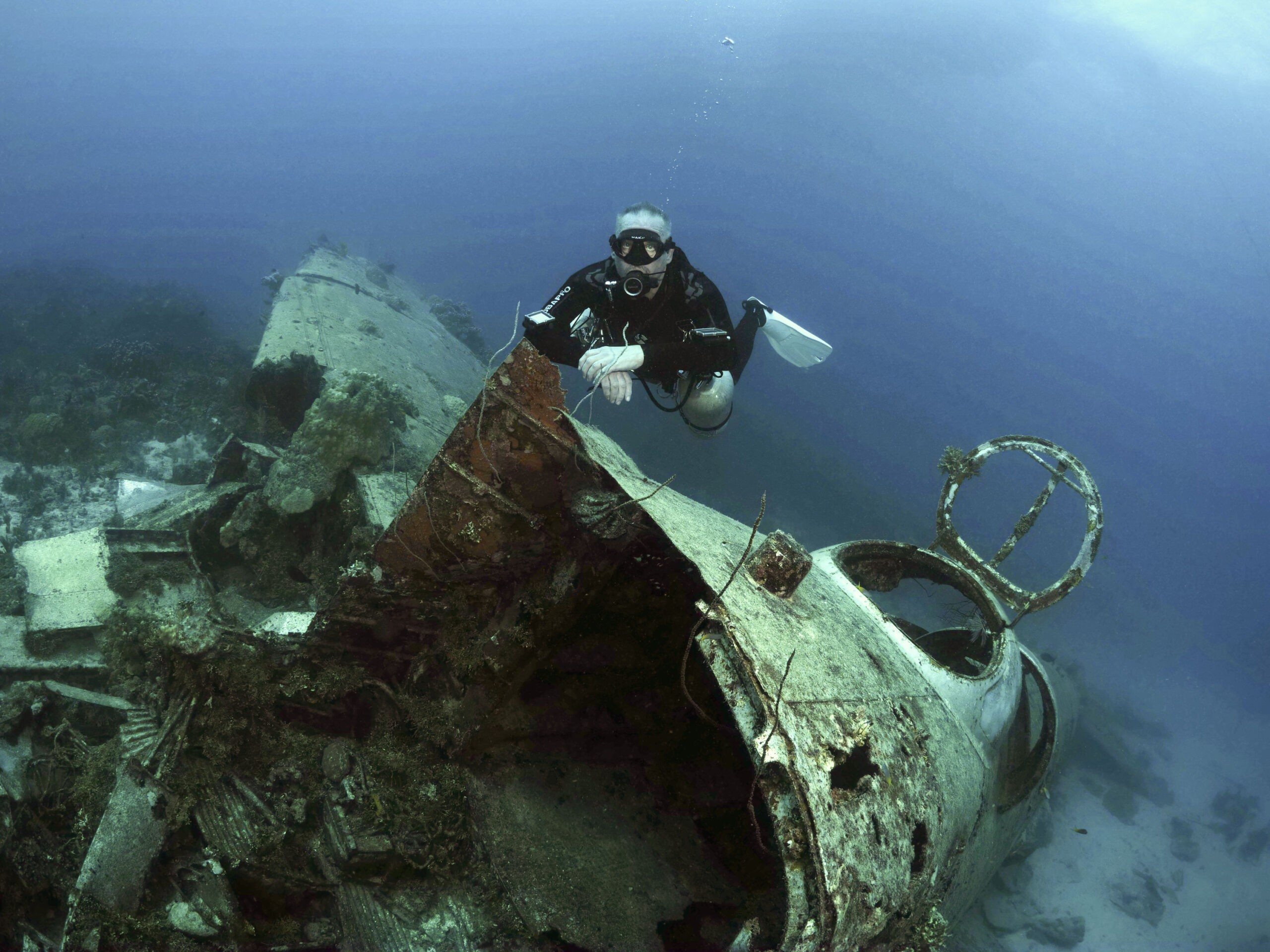Shearwater Dive Computer Comparison
I’ve wanted to write this article for a long time. Before I get started comparing Shearwater dive computers, let me admit to personal bias. I have been diving with Shearwater computers for a long time—at least since 2011.
At that time, Shearwater was primarily known among technical divers. Shearwater dive computers were more crudely constructed than today, but fundamentally the same design. I had used friend’s Predator for a number of dives, but was still mostly doing technical dives by cutting tables using GAP on a Netbook that I still have.
My first Shearwater dive computer was one of the very first Petrels. I ordered it the same day the Petrel was announced. Shortly after, I bought a second Petrel and replaced the first one with a Pretrel 2, so that I could upload my dive log on my phone. The original used a different version of Bluetooth hardware that could only connect to a computer.
Meanwhile, I bought a Perdix for some reason. I liked that it was smaller, but ended up giving it to a business partner. By giving, I really mean “loaning,” but that was several years ago, so I don’t think I am getting it back.
As of now, my personal dive computers are both Shearwater Petrel 2. One has a Fischer connector for my rebreather. The other is just a plain ol’ Shearwater Petrel 2. I typically dive with both unless I am teaching open water classes.
Diving with Two Computers

I like diving with two Shearwater computers. For technical diving, backups are mandatory, but I also prefer to have my tissue loading backed up when traveling, since a computer failure guarantees losing at least one dive day.
Several years ago, I started customizing each computer to display different information. That way, I can display TTS, @+5, average depth, current time, PO2, GF99 and other information all at the same time. Since I am an underwater photographer, I often balance diving tasks with camera operation. Having depth, time and NDL info on both arms makes it easier to focus on the image without having to turn my head to monitor my dive.
Of course for the rebreather, PO2 monitoring is critical. My rebreather set up is pretty simple—Fischer on the left, constant PO2 mode on the right for backup. It’s a KISS, so there’s no controller to back up.
Shearwater Dive Computer Models
I think it will be helpful to categorize the available Shearwater dive computer options. I think of them this way. The first group is technical diving computers in the original, brick-like form factor. There are “watch-style” variants that are also fully capable technical diving computers. I tend to think of all the diving “watches” as part of the same category.
At opposite ends of the diving spectrum are rebreather computers (NERD, Fischer and 4-pin variants, and CCR controllers), and Shearwater recreational diving computers (Peregrine and Tern).
The lines are a little blurry, since there are recreational and technical variants of brick and watch-style computers.
Shearwater Technical Diving Computers

The current range of Shearwater technical diving computers (without PO2 monitoring) include the Perdix 2, Teric and Petrel 3.
These represent to me what Shearwater dive computers are all about. They are all multi-gas, trimix capable dive computers that can be configured for almost any dive. This includes fixed set point CCR diving.
There is a significant difference in price between these computers and the strictly recreational models—about $500, more in some cases. However, if your are thinking of buying a Shearwater dive computer, these are worth considering. Personally, I think this is a smart choice even for strictly recreational divers.
Recreational Dive Mode vs. Technical Diving Modes
Several years ago (before the Peregrine and Tern came out), Shearwater introduced “recreational dive mode” as a setting for the Perdix and Petrel. Recreational mode simplifies the display, dive planning and some of the button sequences. I touch on the specifics shortly.
A lot of recreational divers assume that they have to dive in “recreational” dive mode. To me, a main advantage of choosing a Shearwater technical diving computer is that they provide any diver with much more information.
It’s worth noting that, regardless of the information that’s on the display, Shearwater dive computers calculate decompression and tissue loading the same way.
Given that, why not give yourself more information to use throughout your dive? Technical diving mode provides the ability to customize your display, as well as how decompression is calculated. If you are at all serious about your diving and enjoy learning and make an effort to improve your skills, a Shearwater technical diving computer using a technical diving mode, is worth considering. I’ll add that if you are the type of person that reads user manuals, definitely get a Perdix, Petrel or Teric.
Choosing Shearwater Technical Diving Computer (Even for Recreational Divers)
I believe all of the current Shearwater technical diving computers are air integrated as long as you buy the transmitter. I just use gauges, but most of my dive buddies are air integrated and love it. For me, I don’t care to add bulk to my regulator first stage.
Before moving on to individual Shearwater dive computers, I should mention all current models except, I believe, the Peregrine and the Tern have a digital compass built in. I’m definitely glad it’s there, but I tend to rely on an old school analog compass that I clip to a waist d-ring. I find it awkward to bend my arm into the right position to line up the lubber line.
Shearwater Teric
Choose the Shearwater Teric if you mostly dive in warm water and don’t mind losing some screen real estate compared to the Perdix and Petrel. Shearwater calls the Teric their “most advanced compact dive computer.”
The Teric is a great option if you don’t dive in a drysuit and if you like to wear you dive computer as a watch. As far as diving modes are concerned, the Teric has all of them, minus PO2 monitoring for CCR.
Teric Diving Modes
- OC REC: Nitrox to 99%
- OC TEC: Trimix enabled
- CC/BO: Fixed PPO2
- Gauge: Bottom timer with stop watch and dive logging
- Freediving: Configurable sampling rates and alarms
Shearwater Teric Features
- Decompression computer
- Air Integrated
- Up to 4 transmitters
- 3 axis, tilt compensated, digital compass
- Bluetooth® wireless technology
- Switchable audible & vibration alerts
- Upgradeable firmware
- 316 Stainless bezel and buttons
- 22mm Strap size (extender included)
- Ballistic nylon polymer case
Shearwater Perdix 2
I mentioned earlier that I bought a Shearwater Perdix and liked it a lot—right up until I loaned it to my klepto business partner. To me, the Perdix is the best choice for divers that want lots of screen space, the most customizable layout and a more compact dive computer than the Petrel.
The Perdix works well with a drysuit as well. This is because, unlike Shearwater watch-style dive computers, the Perdix and Petrel have straps that are made of flat bungee material with fasteners that clip together and tighten by pulling on the lose end. My only complaint is they get brittle in extreme cold, so I have broken a few when breaking my gear down after a Winter dive.
These computers also work with round bungee straps that a lot of technical divers like to use for compasses or slates. I personally prefer the stock Shearwater straps because they work better with my DUI Zip Seals.
The Shearwater Perdix 2 for Serious Divers
For those who care, which is almost everyone but me, the Perdix is air integrated. One day, I might reconsider sticking with analog gauges—especially for sidemount diving. Earlier this year, I spent a week in Truk Lagoon and had to grab one of my gauges before every dive and spin it around to get it to stop leaking. That’s not an unusual thing. I don’t know what’s changed in recent years, but high pressure swivels and o-rings just seem to suck. Even brand new ones leak air.
Shearwater’s transmitters won’t leak, and there are other advantages to being air integrated. Obviously, monitoring tank pressure on your computer is cool. With analog, checking pressure takes more than a glance at my wrist. Not that it’s a big deal to look at a gauge, but air integration also means constant monitoring of your SAC rate. I think a lot of divers would benefit by paying attention to how fast they consume breathing gas.
Shearwater Perdix 2 Battery (Good Old Fashioned AA)
One of my absolute favorite things about the Perdix 2 (and Perdix 1), as well as all versions of the Shearwater Petrel is they run on a single AA battery. You can use whatever type of AA battery you wish. I use plain ol’ alkaline batteries in mine. In cold water (usually about 42 degrees F), I’ll get around 30 dives before the icon turns yellow. In warm water, I often get double that. Shearwater estimates 40 hours on alkaline batteries. Lithium is more. I don’t care, since alkaline batteries are cheap and easy to find.
This alone is reason enough for me to turn my nose up on the watch style computers and the Peregrine, which are rechargeable. In theory, rechargeable dive computers seem like a great idea. For a lot of divers they are, but if your computer is dead before a dive, you’re stuck. Good planning solves this, but I personally don’t want to be reliant on carrying a charger.
Shearwater Perdix 2 Alerts
The most recent Shearwater computers have vibrating alerts. You can set these for depth, time, tanks pressure, NDL, PO2 and probably some other conditions divers need to care about. I personally think training and good diving habits are safer than relying on your dive computer to tell you when things might be going bad.
There is never a time during a dive that I don’t know all of these things. Even with distractions like cameras, currents and students, I always am aware of my depth, NDL (or decompression obligation), tank pressure and what’s happening among other divers. For technical and rebreather dives, I am aware of more than that. You probably are too.
I am fine with computers having an alert function. I just don’t need or use it.
My Verdict on the Shearwater Perdix 2
I love the Perdix 2. That’s it. If you are shopping for a dive computer and don’t dive a rebreather, the Shearwater Perdix 2 is the computer to get. Actually, even if you do dive with a rebreather, the Perdix 2 is awesome—it just can’t monitor PO2 in the loop. It has a closed circuit / bail out mode (CC/BO) the same as the Petrels.
The more I think about it, I believe the Perdix 2 with air integration is THE setup for sidemount divers. It allows you to tuck your first stages deep under your armpits and never look down to know how much gas you have in each cylinder. The only thing I wonder about is the added bulk of the transmitter. I think that’s not much of an issue though.
Shearwater Perdix 2 Features / Specs
Shearwater Perdix 2 Modes
- Air
- Nitrox
- 3 Gas Nitrox
- OC Tec – Multi gas, trimix decompression computer
- CC/BO – Closed circuit fixed PPO2
- Gauge – Bottom timer with stop watch and dive logging
Shearwater Perdix 2 Features
- User replaceable AA battery
- Air, nitrox, trimix capable
- Quick OC bailout from CC
- Decompression computer
- Dive planning
- Bühlmann GF algorithm
- Optional Air integration
- Connects up to 4 transmitters (optional)
- 3 axis, tilt compensated, digital compass
- Strong vibration warning alerts (Only 1.5V non-rechargeable lithium and 3.7V lithium rechargeable batteries support vibration functions.)
- Optional VPM-B, Optional DCIEM
- Dive logging
- Bluetooth wireless technology
- Upgradeable firmware
Shearwater Petrel 3 (Petrel 3 EXT & Petrel 3 AK 4-PIN) Dive Computer
The Shearwater Petrel 3 came out about 15 minutes after I bought my Petrel 2 EXT. I was thrilled about that. The main thing is the Petrel 3 supports air integration. The Petrel 2 does not.

In general, the Petrel differs from the Perdix in that it is larger and more robust in construction. I don’t anticipate anyone breaking their Perdix, but the Petrel is definitely a brick. What the Petrel offers that the Perdix doesn’t is PO2 monitoring for CCR divers.
The Petrel 3 EXT is the Shearwater designation for models with PO2 monitoring via Fischer connector. Chances are, if you are a rebreather diver, you already know what model Shearwater dive computer is appropriate for your rebreather and your specific diving needs. In my case, this is the one I use for my KISS rebreathers.
I have a cable that runs from the sensor housing on the rebreather. It has a connector that mates with the Petrel dive computer on my left wrist. Inside the rebreather, the cable uses Molex connectors for each sensor.
In CC EXT mode, my Petrel middle row displays the current PO2 reading for each sensor (converted from the millivolts of the individual sensors). The Petrel itself has a method for calibration along with some other setting specific to CCR diving.
Petrel 3 AK 4-PIN works the same way, except that it uses the 4-Pin type connector rather than a Fischer connector. My understanding is that 4-Pin connectors are more secure, less fragile and potentially more waterproof than Fischer connectors. I am meticulous about maintenance and somewhat paranoid about keeping my Fischer connectors clean and protected.
My Shearwater dive computers include a Petrel 2 EXT (Fischer) and a Petrel 2. For open circuit diving, I use the Petrel 2 EXT with the Fischer cap in place. I set it to Open Circuit Tec mode. I set the Petrel 2 to the same mode and wear it on my opposite arm. As mentioned earlier, I have each dive computer configured to display different information, aside from depth, gas and decompression data that appears on both.
The Shearwater NERD 2 (NERD 2, NERD 2 Fischer, NERD 2 (4-Pin))
The Shearwater NERD (Near Eye Remote Display) provides a hands-free means for keeping dive data visible throughout your dive. It is most commonly used by technical diver—especially rebreather divers. In CCR diving, the number one rule is to ALWAYS know your PO2. The NERD puts this and other information front and center always.
A lot of CCR divers will wire their sensors to both a Petrel EXT (all versions) and NERD simultaneously. This provides a backup for realtime PO2 monitoring, as well as better visibility for what your current PO2 actually is.
The NERD (EXT versions) attach directly to your CCR loop hose next to your DSV/BOV. The non-EXT version is basically an open circuit HUD that attaches to your regulator second stage hose. In concept, I like all of the NERD versions, although I have never used one.
At some point, I may get a NERD EXT, but being an underwater photographer, I don’t know that it’s ideal. I’m interested to hear from CCR divers that are serious/professional underwater photographers that use the NERD for CCR diving. Email me or comment below.
Shearwater Recreational Dive Computers
I realize this may have been a little backwards, but I finally come around to Shearwater for strictly recreational diving. Shearwater recreational dive computer models include the Peregrine and the Tern. The Peregrine is a brick and the Tern is a watch. Both are rechargeable, so forget what I said about using AA batteries for these.

Both offer versions that are air integrated. These are the Peregrine TX and the Tern TX. They are functionally 3-gas nitrox dive computers. Unlike some competing dive computers, the Peregrine and Tern won’t lock you out in the event of a violation or if you happen to “go into deco.” The deco schedule is the same is it would be diving with any other Shearwater dive computer, assuming the default gradient factor (GF) setting of 40/85.
(As a side note, you should never just “go into” deco. As soon as you introduce a decompression obligation to your dive, you take away the surface as a safe option for dealing with a problem. Without the proper training and equipment, this can be very risky.)
All Shearwater dive computer models have a great display that’s easy to read underwater. The layout is the same as other Shearwater dive computers set to “recreational” mode. They all are easy to learn and navigate, so unless you budget is a major concern, I tend to lean toward the full-featured models like the Perdix and Teric as a better long term option for most divers.
Are Shearwater Dive Computers Worth It?
Yes, they are absolutely worth it. For me, Shearwater dive computers are in a class by themselves. More than that, I am constantly surprised and a little disappointed when I see divers using other brands.
In recent years, I’ve begun seeing dive computers from other manufacturers that are obviously taking notice. Given that, I am open minded and look forward to watching the dive computer market continue to evolve. I’m watching a few of them now with great interest.
For now, I’m solidly on Team Shearwater. I welcome your thoughts!



I was recently locked out of my Suunto computer because I chose free dive mode by mistake. Pissed me off. I service my gear regularly, I don’t dive that often, and I want my expensive dive gear to work properly when I do. My service tech raves about Shearwater computers, as does every article and review I’ve read on the internet. Wish they were a little bit are affordable, or were discounted occasionally.
Hi Keith, I definitely feel your pain about the price of Shearwater dive computers. One thing I like about them is they treat you like an adult. They provide your tissue loading data. It’s up to you to use your knowledge and dive skills to make good decisions. I’m not too excited about the Peregrine because it is limited to recreational diving and doesn’t run on AA batteries. They are pricey, but everything you read really is true. Thanks for the comment!